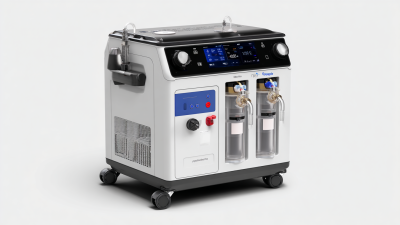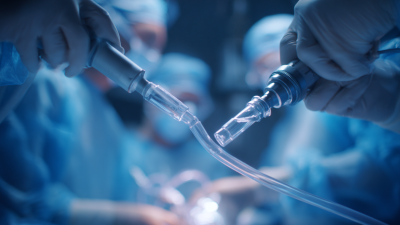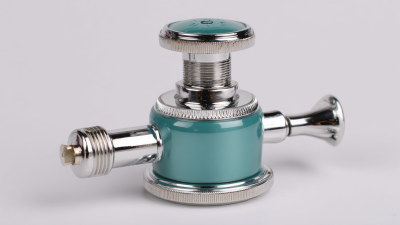In the ever-evolving landscape of healthcare, the adoption of technology plays a crucial role in enhancing patient safety and operational efficiency. Among these innovations, the Central Suction Machine stands out as a transformative tool that streamlines clinical procedures and improves patient outcomes. According to a report by the World Health Organization, proper suction management can reduce the incidence of healthcare-associated infections (HAIs) by up to 30%, a staggering statistic that underscores the importance of effective suction solutions in clinical settings. Additionally, a study published in the Journal of Patient Safety noted a 25% decrease in procedure times when utilizing advanced suction systems, demonstrating their impact on efficiency in high-pressure environments. This article explores how Central Suction Machines not only contribute to better infection control but also enhance workflow, ultimately revolutionizing patient care in modern healthcare facilities.

Central suction machines represent a significant advancement in modern healthcare, directly impacting patient outcomes and safety. These sophisticated devices provide continuous and reliable suction, crucial for maintaining clear airways, particularly in critical care settings. By effectively removing secretions and obstructions, central suction systems help prevent respiratory complications, ensuring that patients can breathe more easily during treatment. This real-time intervention not only enhances patient comfort but also plays a vital role in reducing the risk of infections and other complications associated with respiratory distress.
Moreover, the integration of central suction machines into healthcare facilities streamlines clinical workflows, significantly improving efficiency. With the ability to centralize suction capabilities, healthcare professionals can respond swiftly to patients' needs without the delays associated with portable suction devices. This advancement not only saves precious time during emergencies but also allows staff to focus more on patient care instead of managing equipment. Ultimately, the implementation of these machines contributes to a safer and more effective healthcare environment, fostering better clinical outcomes and enhancing the overall quality of care delivered to patients.
Central suction systems play a pivotal role in enhancing patient safety within healthcare settings by significantly reducing the risk of healthcare-acquired infections (HAIs). These systems ensure efficient removal of contaminants, fluids, and debris from medical environments, thereby minimizing the pathogen load that could lead to infections. By providing a sterile and controlled environment, central suction machines help maintain the cleanliness of surgical sites and treatment areas, which is essential in preventing HAIs.
Moreover, the integration of central suction systems into medical facilities promotes operational efficiency. These sophisticated devices streamline the suction process, allowing healthcare professionals to focus more on patient care rather than the logistics of waste management. With centralized suction, staff can easily access suction points throughout the facility, which not only enhances workflow but also reduces the likelihood of cross-contamination. As a result, hospitals are better equipped to safeguard patients against infections while optimizing resource usage and improving overall care outcomes.
 Central suction solutions are transforming healthcare environments by providing an efficient means of airway management and fluid removal. The integration of central suction machines significantly reduces the time healthcare professionals spend on manual suctioning. This streamlined process allows medical staff to focus more on patient care rather than the logistical challenges of suction management. As a result, patients receive timely interventions, which is critical in emergency and surgical settings.
Central suction solutions are transforming healthcare environments by providing an efficient means of airway management and fluid removal. The integration of central suction machines significantly reduces the time healthcare professionals spend on manual suctioning. This streamlined process allows medical staff to focus more on patient care rather than the logistical challenges of suction management. As a result, patients receive timely interventions, which is critical in emergency and surgical settings.
Moreover, centralized systems enhance overall operational effectiveness within hospitals. By eliminating the need for multiple, portable suction devices, facilities can reduce clutter and improve workflow. The easier access to suction resources results in quicker response times during critical situations, ultimately enhancing patient safety. In addition, the reduced risk of cross-contamination and infections, often associated with portable suction units, adds another layer of safety for patients.
Integration of central suction solutions exemplifies how innovation in medical equipment can lead to significant improvements in both efficiency and quality of care.
The cost-effectiveness of central suction machines compared to portable units in hospitals is a critical consideration in modern healthcare. Central suction systems, while requiring a higher upfront investment, often yield substantial savings in the long term. These systems are designed for continuous use, reducing the need for frequent purchases of portable suction devices. Moreover, central systems tend to have lower maintenance costs and require less time for staff training, enhancing operational efficiency.

In terms of patient safety, central suction machines also provide significant advantages. They offer a reliable, consistent suction source that can be easily accessed throughout the facility, minimizing delays in emergency situations. This reliability not only improves patient outcomes but also reduces complications associated with inadequate suction.
Conversely, portable units, despite their versatility, may lead to supply chain issues and varying performance levels, which can compromise patient safety during critical moments. Thus, while the initial costs of central suction systems may be higher, their overall benefits in safety, efficiency, and long-term savings make them a more effective choice for hospitals.
The integration of next-generation suction technology into healthcare is revolutionizing patient safety and operational efficiency. As healthcare facilities increasingly adopt data-driven insights, the emergence of central suction machines showcases a pivotal shift towards smarter, more efficient patient care solutions. These advanced systems not only streamline the suction process but also enhance clinical workflows, reducing the risk of errors and improving response times in critical situations.
Recent trends highlight that the adoption of such technology aligns with broader movements in healthcare innovation, particularly in utilizing big data analytics. In 2024, the emphasis on data-driven healthcare frameworks is expected to reshape patient safety narratives, facilitating the maintenance of optimal suction levels and monitoring system performance in real-time. This evolution enables practitioners to leverage actionable insights, thereby fostering an environment where patient safety is prioritized, and operational efficiencies are maximized. As the healthcare landscape continues to evolve, these advanced suction technologies stand at the forefront, paving the way for enhanced clinical outcomes and streamlined processes.
This chart displays the correlation between the adoption of central suction machines and improvements in patient safety metrics over a five-year period. The data highlights a significant reduction in complication rates and an increase in operational efficiency in healthcare settings.






